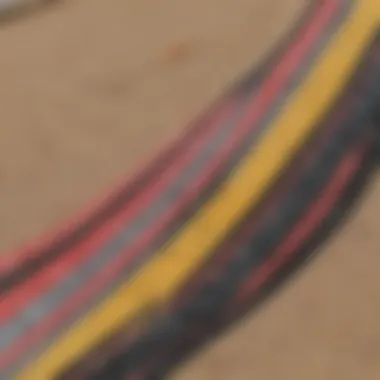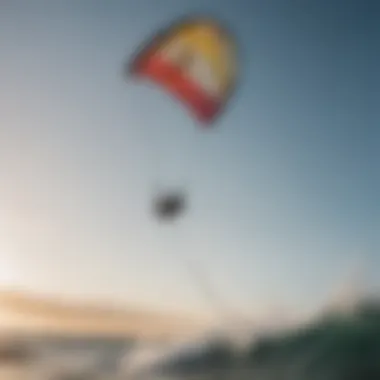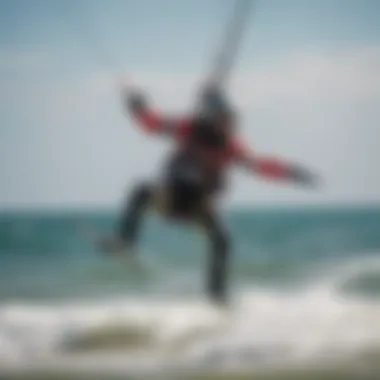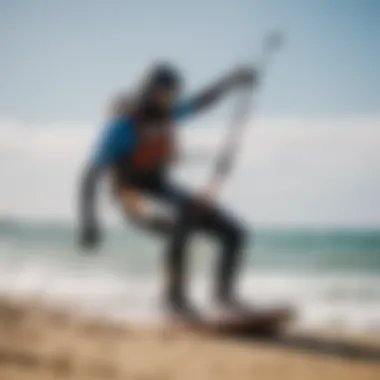Understanding Kiteboarding Lines for Better Performance


Intro
Kiteboarding is a thrilling sport that merges the power of wind with the art of riding waves. At the core of this sport lies kiteboarding lines—often overlooked but essential components that shape the entire experience. Understanding the ins and outs of these lines can make the difference between a mediocre ride and an exhilarating adventure. This guide aims to break down the complexity surrounding kiteboarding lines, shedding light on their various types, crucial materials, and the best practices for selection and maintenance.
You may not realize it, but the lines that connect a rider to their kite play a vital role in performance, safety, and handling. Kiteboarding lines influence how well the kite responds to maneuvers, the rider’s ability to control the kite, and ultimately, the overall enjoyment of the sport. Whether you’re a seasoned kiteboarder or just starting out, knowing the ropes—that is, the lines—can significantly elevate your skills.
Throughout this guide, we will cover the following key areas:
- Different types of kiteboarding lines and their applications
- The materials that make up these lines and their impact on performance
- How to maintain kiteboarding lines for longevity and safety
- Factors to consider when selecting lines that suit your style and conditions
- The latest advancements in line technology
In the upcoming sections, anticipate insightful discussions that will enhance your understanding and relationship with kiteboarding lines, preparing you to tackle waters with confidence and finesse.
Prolusion to Kiteboarding Lines
Kiteboarding lines may seem like just another piece of gear, but they truly are the backbone of the kiteboarding experience. Understanding their role is crucial not only for performance but also for safety on the water. This article will clarify the intricacies involved with kiteboarding lines, diving into the different types and materials, maintenance practices, and their overall importance. For both beginners and seasoned riders, knowing how kiteboarding lines work can elevate one’s skill set and enhances the joys of the sport.
The Role of Lines in Kiteboarding
Lines are not merely functional; they’re essential for control and stability while kiteboarding. They connect your kite to your harness, translating your commands into movement. A rider’s ability to steer and manage the power of the kite is largely determined by line characteristics. For instance, thicker lines can bear more weight but may also weigh the kite down, affecting its responsiveness. Proper attention to line type and wear is vital. If something feels off—a slower response or irregular tension—there might be a hidden issue within the lines. Therefore, paying close attention to them can mean the difference between a thrilling ride and a turbulent experience.
Overview of Kiteboarding Gear
To appreciate kiteboarding lines, one must understand them within the context of kiteboarding gear as a whole. A typical kiteboarding setup includes:
- Kite: The wind-driven component that generates lift.
- Bar: The steering interface connecting the lines to the rider’s control scheme.
- Harness: Worn by the rider, it helps in distributing the kite's pull across the body.
- Lines: Those often-overlooked strands tied to everything, playing a pivotal role in performance and safety.
- Board: The surface on which the rider glides over water.
Each piece serves a unique purpose, with lines acting as the silent communicators that facilitate the interaction between the rider and the kite. Understanding this relationship is key to mastering technique and enhancing overall kiteboarding experience.
Types of Kiteboarding Lines
Kiteboarding lines play a pivotal role in how a rider interacts with the kite. Different types of lines offer specific benefits that can greatly influence performance. Understanding the nuances between these lines can enhance a kiter's experience, allowing them to better control their kite and ultimately improve their skills. Additionally, the type of line can affect settings related to safety and responsiveness, making it an area worth diving into for anyone serious about the sport.
Front Lines
Front lines are the vital connection between the kite and the rider's control system. They bear the load during power transitions and play a significant role in steering the kite. Typically, these lines are attached at the front of the kite and help define its flight path.
For instance, if you stretch a rubber band, the tension you feel is akin to how front lines react—when you pull, the kite responds and shoots forward. Choosing the right material and length for these lines can affect your control and agility. Too much slack can lead to delayed responses, while overly tight lines may give you a stiff ride. Riders who favor speed and agility might opt for slightly shorter front lines to enhance their reactions.
Back Lines
Back lines provide stability, helping to balance the lift generated by the kite. They are often what helps keep the kite oriented correctly in the air. If front lines are akin to the accelerator pedal in a car, back lines would be like the brakes—offering a mechanism to slow down or fine-tune maintaining kite position.
When selecting back lines, it's essential to consider their length and elasticity. Shorter back lines might offer quicker response times, whereas longer ones can provide more range. However, it's a delicate dance: too long can lead to the kite feeling too ‘soggy’ and hard to maneuver, while too short can crank up the pressure and overwhelm the rider with responsive action. Better understanding of personal riding style often aids in this selection.
Center Lines
Center lines serve a unique function—they help organize the entire line setup, keeping things neat and manageable. These lines are pivotal when it comes to aspects like safety releases since they connect the rider to the safety systems.
To give you a picture, imagine holding a handful of spaghetti. If many strands are tangled, it becomes hard to pull each one efficiently. Similarly, if center lines are properly set, untangled, and maintained, they offer safer and more straightforward access to emergency systems.
In addition, center lines can influence the kite's overall balance in the air. They determine how the kite hits the wind, affecting lift and drag. If riders frequently expect to engage in quick turns or transitions, adjusting the tension in these lines can lead to improved handling.
Adjustable Lines
Adjustable lines are somewhat of a game-changer in the kiteboarding world. They offer flexibility, allowing riders to fine-tune their setups based on wind conditions or personal preference. Imagine being able to alter the grip of a bicycle's brakes while riding. That’s what adjustable lines do for a kiteboarder.
To take advantage of this feature, a rider can lengthen or shorten the lines in real-time, adapting to changing gusts or personal comfort levels. However, adjustment needs to be done with care—mismanagement can lead to unexpected behavior from the kite. Proper use of adjustable lines helps with negotiations in tricky weather situations, giving a more tailored riding experience without needing to switch out gear completely.
"The right type of line can turn an okay performance into an exceptional one. Choosing wisely allows for tailored experiences across various environments."


Knowing how each type interacts with the rest of the gear gives kiteboarders a clearer picture of making informed choices, resulting in better rides and adventures.
Materials Used for Kiteboarding Lines
When it comes to kiteboarding, the materials that make up your lines are more than just technical specifications; they are fundamental to how the entire setup performs. The choice of materials can significantly influence durability, stretch, weight, and overall safety, playing a vital role in the experience on the water. By understanding these materials, kiteboarders can make informed decisions that align with their riding style and conditions they usually face.
Spectra Lines
Spectra lines, made from ultra-high molecular weight polyethylene, have become a popular choice in the kiteboarding community. Their notable advantages include a very high strength-to-weight ratio and minimal stretch, which provides better control and responsiveness when maneuvering. Riders often remark that the lack of stretch allows for a steady pull, making it easier to handle the kite precisely.
However, it's worth noting that Spectra lines can be more susceptible to UV degradation compared to other materials. This means that while they perform well, it is crucial to safeguard them from prolonged sun exposure whenever possible.
Another point to consider is that, although Spectra is incredibly strong, it can be vulnerable to abrasions. If you're often hitting harsh objects or riding in rocky areas, be mindful of this material's limitations.
"Choosing the right line materials is as much about personal preference as it is about technical performance."
Dyneema Lines
Next up is Dyneema, which shares some similarities with Spectra but boasts superior UV resistance and lower moisture absorption. This translates into lines that maintain their performance over time, even under tough conditions. Dyneema is a favorite among those who often ride in varying climates and want something reliable and enduring.
The feel of Dyneema lines often is described as consistent and smooth, contributing to better handling of the kite. Riders appreciate the enhanced durability these lines offer, which can save on future replacement costs. Another advantage is that they typically come in a wider range of weights and thicknesses, allowing for more customization based on a rider's needs.
Despite these advantages, the trade-off with Dyneema lines is often cost. Purchasing Dyneema can require a bit of a hole in one's pocket, but many riders argue that the longevity makes it worth the investment.
Nylon vs. Polyester
When comparing nylon and polyester, the differences are quite striking. Nylon is used in some kiteboarding lines due to its high elasticity, which can absorb shock loads effectively. While this can make for a buttery-smooth ride, it can also introduce a learning curve for beginners, as the stretching can cause a delay in kite response.
Polyester, on the other hand, is known for its lower stretch properties and resistance to UV rays. This makes polyester lines more durable in the long run, especially when exposed to sun and saltwater. A common challenge with polyester is that it may feel stiffer, requiring a bit of time to get used to the handling characteristics.
The strengths and weaknesses of these two materials often lead to the choice being driven by personal preference and intended use. Many kiteboarders experiment with both to discover what suits their style and comfort levels.
In summary, the choice of materials for kiteboarding lines is critical and should align with the rider's specific needs. Whether one opts for the strength of Spectra, the endurance of Dyneema, or the classic reliability of nylon and polyester, understanding the unique properties of each can enhance performance and safety on the water.
Length of Kiteboarding Lines
The length of kiteboarding lines is not just a trivial aspect; it plays a vital role in how a kite performs. Understanding the different line lengths and their implications can greatly affect your riding experience. The primary consideration revolves around how line length can alter a kite's dynamics, impacting everything from handling to stability and even the overall safety of the sport. A kite with the right line length can offer a balance between control and power that is crucial for maneuvering through diverse wind conditions.
Standard Line Lengths
When it comes to standard line lengths, there isn't a one-size-fits-all solution. Most kiteboarding setups come with lines that typically range between 20 to 30 meters. Here’s a brief overview of commonly used lengths:
- 20 Meters: Popular for freestyle and unhooked tricks, this length provides a more direct feel, making it easier to perform quick maneuvers.
- 24 Meters: This is often seen as the middle ground, suitable for a balanced performance, offering a mix of control and power that is favored by many kiteboarders.
- 28 Meters: Favored for wave riding, longer lines allow the kite to fly higher, generating more lift and giving the rider better performance in bigger waves.
- 30 Meters: Used at lower wind speeds, these lines can help to maximize the power of the kite, making them suitable for heavier riders or those who prefer a more powerful pull.
Each length has its unique pros and cons, tailored for different styles and conditions. Selecting the right length not only enhances performance but also caters to personal preferences and riding styles.
Effects of Line Length on Performance
The choice of line length has a notable effect on kite performance. Understanding these effects can help a rider optimize their setup.
- Responsiveness: Shorter lines typically result in quicker response times. This immediacy can help in executing fast turns and tricks, which is essential for freestyle riders. However, this may come at the cost of stability in gusty winds.
- Lift and Power: Longer lines allow the kite to fly higher, capturing more wind and generating greater lift. Riders looking to jump or ride waves might find that longer lines give them better hang-time and power for their moves.
- Control: The longer the lines, the greater the distance between the rider and the kite. This can lead to reduced control in certain situations where swift adjustments are needed. Conversely, shorter lines can provide a more tactile connection, but they might make handling tricky in high winds.
- Wind Speed Effectiveness: Kiteboarding in lighter winds often benefits from longer lines as it helps the kite achieve greater lift. In contrast, in high winds, shorter lines can keep the kite manageable and reduce the risk of overpowering.
It's important to align your line choice with your skills and the conditions you'll be riding in.
In summary, the length of kiteboarding lines has significant effects on performance, and making an informed decision about line length can enhance both your enjoyment and safety while riding. As you gain experience, experimenting with different line lengths can further refine your setup to suit your individual style.
Performance Factors Influenced by Lines
Kiteboarding is not just about the thrill of riding the waves; it heavily depends on the connection between the kite and the rider. At the very heart of this connection are the lines that facilitate every movement and maneuver. Understanding how these lines impact performance can be the difference between a mediocre ride and a flawless one. Here, we delve into two critical performance factors influenced by lines: steering response and power management.
Steering Response


The steering response of a kite is largely governed by the lines attached to it. When a rider pulls on the control bar, the front lines that connect to the kite come into play. The tension and length of these lines dictate how quickly the kite will respond to steering inputs.
- Tighter Lines: In general, tighter lines can improve immediate steering response. This means that the kite will turn more sharply and quickly. However, too much tension might turn a joyride into a struggle if the kite becomes overly sensitive.
- Looser Lines: On the other hand, looser lines tend to provide a more gradual steering response. This can be beneficial when riding in choppy water or during tricks, where subtle adjustments are needed.
A kite that responds well has a personalized touch, allowing a rider to dance through the wind with precision. An essential aspect to remember is that line length plays into the steering effectiveness. If lines are too long, the response time will diminish, creating a lag that may not be desirable during high-paced maneuvers.
"A kite that dances with the wind gives the rider control, while being in tune with the flow becomes an art form."
Power and Depower
Another significant factor influenced by lines is the kite's power and depower capabilities. Power in kiteboarding refers to how much pull the kite generates, while depower signifies the ability to reduce that pull, which is crucial when conditions become overwhelming.
- Front Lines and Power: The front lines primarily manage the amount of power a kite generates. For instance, pulling on the control bar increases tension on these lines, resulting in more pull from the kite. Riders seeking to catch massive air or maintain control in strong winds will require a robust setup here.
- Back Lines and Depower: Conversely, the back lines play an essential role in managing depower. When the rider pushes the control bar away, it slackens the back lines, allowing the kite to “flap” a bit, which reduces its pulling force. This is particularly important when navigating gusty conditions, where huge power surges can easily throw a rider off balance.
Understanding how to balance power and depower through line selection greatly enhances a rider’s control over their experience. Opting for lines that facilitate both powerful pulls and quick depower adjustments ensures a safer, more enjoyable ride, especially for those who like to explore challenging conditions.
In summary, recognizing the influence of lines on performance factors such as steering response and power management is crucial for any kiteboarding enthusiast. Careful consideration in line choice can elevate both safety and enjoyment in the sport, making it an indispensable aspect of kiteboarding gear.
Safety Considerations in Line Choice
When it comes to kiteboarding, choosing the right lines isn’t just about performance; it also ties directly into safety, which should always be a kiteboarder's top priority. Kiteboarding lines, though they might seem like straightforward tools, hold significant power in determining how a kite behaves in the air. This section dives into the risks associated with line breakage and the proper maintenance practices that can mitigate potential hazards, ultimately enhancing your overall kiteboarding experience.
Line Breakage Risks
The thought of a line snapping during a kiteboarding session can be terrifying. After all, the lines are what connect you to the kite, controlling its movements and your safety. If you’ve seen someone experience a line break, you understand the potential chaos that can ensue. The risks are often multifaceted:
- Material Fatigue: Over time, the materials used in lines can degrade due to exposure to UV light, saltwater, and physical abrasions. This fatigue weakens their strength significantly. A line that appeared sound can break unexpectedly.
- Improper Use: Many kiteboarders might underestimate the torque and pulls applied on lines during various maneuvers. Failing to account for these forces can lead to surreptitious wear and tear.
- Environmental Factors: Weather can also play a villain's role. Wind conditions, particularly gusts, can lead to sharp tugs on the lines. Sustained heavy winds without the right line strength can cause breakage.
To minimize these risks, one must ensure they are not just using quality lines but also regularly inspecting them for signs of wear.
Proper Maintenance
Proper maintenance is the name of the game when it comes to kiteboarding lines. Just like you wouldn’t neglect your car or bike, your kiteboarding gear needs the same kind of care. Here are some tips to tether you to safe practices:
- Routine Inspections: Make it a habit to check your lines regularly. Look for frays, discoloration, or stiff spots. If anything looks off, it’s better to err on the side of caution and replace the line.
- Washing Lines: A simple rinse with fresh water can go a long way. After sessions in saltwater, give them a good wash to avoid salt accumulation which can lead to corrosion or deterioration over time.
- Avoid Over-Loops: Ensure your lines are properly stowed and not tangled up. Unraveled lines can lead to a mess and unpredictable performance. Neat storage and elimination of knots will prevent pressure points on lines.
- Store Wisely: Lines should be stored away from direct sunlight. Heat can warp and damage them. Keeping them in cool, dry conditions prolongs their lifespan and keeps them functional.
"Proper care of kiteboarding lines not only enhances performance but ensures that safety remains paramount. A stitch in time saves nine!"
Understanding these safety considerations isn’t merely good practice; it’s essential for anyone serious about kiteboarding. As with any adventure sport, respecting your equipment can lead to a far safer and more enjoyable experience on the water.
Maintenance and Care for Kiteboarding Lines
Kiteboarding lines play an integral role in the overall performance and safety of your kiteboarding adventures. Just like a well-oiled machine, the lines need regular care and attention to function at optimal levels. Keeping them clean and stored properly not only extends their lifespan but also ensures that you remain safe and responsive on the water.
Failure to care for these essential components can lead to diminished performance, a potential for line failure, and ultimately compromises your safety. The rigmarole of proper maintenance might seem tedious, but it’s a small price to pay when considering the stakes involved in kiteboarding.
Cleaning Techniques
Cleaning your kiteboarding lines is crucial for maintaining their integrity. Over time, dirt, sand, and salt can accumulate on the lines, degrading the fiber strength. Here are some effective cleaning methods you might find useful:
- Freshwater Rinse
After each session, it’s beneficial to rinse your lines with freshwater. This removes salt and contaminants which can cause long-term damage. - Soaking
For a thorough clean, you can soak your lines in a tub full of lukewarm water mixed with some mild soap for a short while, generally less than an hour. This helps to break down any stubborn dirt. - Gentle Scrubbing
If you encounter particularly dirty sections, a soft brush can be effective for removing debris. Remember to be gentle to avoid causing wear on the lines. - Drying
Always lay your lines flat to dry in a shaded area; don’t hang them up since that can cause unnecessary stretching.
By adopting these cleaning techniques, you'll be ensuring your lines remain in top shape.
Storage Recommendations
Proper storage is just as important as cleaning when it comes to prolonging the life of your kiteboarding lines. Storing them poorly can lead to fraying or tangling, which can be a hassle to deal with. Here are several tips for effective storage:
- Avoid Sunlight
Long-term exposure to sunlight can weaken the materials. Store your lines in a dry, cool place away from direct sunlight. - Use Line Bags
Using specialized line bags will help keep your lines organized and tangle-free. This saves you time during setup and climb down from the water. - Loosely Coiled
When storing, coil your lines loosely to avoid kinks or twists that can stress the material. - Regular Inspection
Take time to inspect your lines during storage. Look for any signs of wear, fraying, or discoloration that may indicate damage.


By adhering to these storage recommendations, kiteboarders can significantly enhance the longevity and performance of their lines, allowing them to enjoy their time on the water without concerns.
Selecting the Right Lines for Your Kite
Choosing the right lines for your kite is more than just grabbing what’s on sale at the local shop. This decision shapes your entire kiteboarding experience, from performance to safety. Kite lines aren't just strings connected to your kite; they are a vital link that determines how your kite handles, how responsive it is, and ultimately, how comfortable and safe your sessions will be.
Several elements come into play, influencing both your choice and usage of kiteboarding lines. Firstly, understanding the different types of lines available is crucial. The characteristics of each line type can have varying impacts based on the conditions you're riding in. An intermediate rider may have a vastly different need compared to a pro chasing high winds or waves. Specificities like line length, material, and strength all weigh heavily on this choice.
Additionally, having good lines can improve your control over the kite. Lines that are worn or damaged can lead to unpredictable behavior, which could spell trouble for even the most experienced rider. Hence, investing in proper lines bolsters both enjoyment and safety, emphasizing the importance of this part of your gear.
Factors to Consider
- Riding Style: Whether you’re into freestyle, wave riding, or cruising will change the type of lines you want. Freestyle kiteboarders often require more sensitivity, while wave riders may favor durability.
- Line Length: Longer lines typically allow for more power and speed. However, they might compromise control, especially in high winds. Always think about where you'll be riding and what conditions you'd face.
- Material Type: Different materials like Spectra or Dyneema offer unique advantages. Dyneema is super strong yet lightweight, while Spectra provides excellent handling in varying conditions.
- Weight Considerations: The overall weight you’ll pull when kiting should be factored in. Lighter lines might make the ride feel more agile, while heavier ones may track better in certain conditions.
Recommendations for Beginners
As someone just dipping their toes into kiteboarding, it can certainly seem overwhelming to navigate the myriad of choices. Here’s what to consider:
- Opt for Standard Lengths: Beginners usually benefit from using standard line lengths. This makes learning simpler without the extra variables of custom lengths.
- Choose Durable Materials: Newbies may err in maintaining their gear, so opting for durable materials is wise. Look for Dyneema or materials that can withstand wear.
- Seek Out Easy Setup Systems: Lines with built-in strips or color codes can make setups easier, reducing the chances of mistakenly attaching them incorrectly.
- Don’t Skimp on Quality: While it’s tempting to go for cheaper alternatives, remember that your safety hinges on the quality of your equipment. Invest in trusted brands like North, Slingshot, or Cabrinha that have a reputation for durable and reliable products.
"Choosing the right lines is as important as choosing the right kite."
By taking the time to research, consider your personal riding style, and invest wisely into your equipment, you set yourself up for a more enjoyable and safer kiteboarding experience. Selecting your kite lines isn't just a decision; it's an essential step towards mastering the waves.
Advancements in Line Technology
The world of kiteboarding is constantly progressing, and advancements in line technology form a key piece of this puzzle. As kiteboarders collectively push the limits of performance, the lines they use become crucial not just for hold but for enhancing every ride experience. Lines that are lighter, stronger, and more responsive lead to significant improvements in maneuverability. This, in turn, translates to better safety and performance, both essential aspects for any kiteboarding enthusiast.
New Materials and Innovations
Recent years have seen a shift towards cutting-edge materials in the production of kiteboarding lines. These innovations aim to provide kiteboarders with enhanced performance and longevity. One notable example is the incorporation of woven Spectra and Dyneema fibers, which both offer lightweight strength and reduced stretch. This is a big deal because reduced stretch means more control during high-speed riding.
Additionally, technologies that involve coatings to resist saltwater corrosion contribute to durability. When you’re out on the water, having lines that can withstand the elements provides peace of mind.
- Lightweight Composition: Innovations focus on creating lighter lines without compromising strength, which aids in speed and response time.
- Durability Enhancements: New coatings are applied to resist wear and tear, ensuring the lines stand up to repeated use in diverse weather conditions.
"The modern kiteboard line doesn’t just hold the kite; it enhances every nuance of riding. The synergy of materials and technology significantly elevates the sport."
These advancements are vital, especially for riders who frequently venture into challenging environments. With stronger materials, they minimize the risk of breakage even under intense conditions.
Future Trends in Kiteboarding Lines
Looking ahead, we can expect further advancements that reinforce the overall kiteboarding experience. Expect to see innovations that integrate technology for data collection—think smart lines that could monitor tension and other performance metrics. This would allow for real-time adjustments and informed predictions regarding line performance under varying conditions.
Another trend likely to gain traction is the continued refinement of biocompatible materials, which will appeal to environmentally conscious kiteboarders. Eco-friendly alternatives that don't sacrifice durability are on the horizon as manufacturers recognize the need to balance performance with sustainability.
In summary, advancements in line technology hold great importance for kiteboarding enthusiasts seeking reliability and improved performance. The coming years promise exciting developments, from new materials to transformative technology, setting the stage for the next wave of innovations in kiteboarding lines.
Ending
The conclusion serves as a pivotal section in our exploration of kiteboarding lines, a crucial component that underpins every kiteboarding experience. It wraps up the extensive discussions and reflections we've had, consolidating the critical information regarding the types, materials, maintenance, selection, and advancements in line technology. This section ensures that readers leave with a clear understanding of why kiteboarding lines are not merely an accessory but rather a fundamental aspect that can dramatically influence performance and safety on the water.
Understanding the technical details and nuances of kiteboarding lines helps riders make informed decisions. For example, whether to choose lighter lines for faster steering or thicker lines for enhanced durability becomes essential as users refine their personal preferences and riding styles. This choice can be further impacted by factors like wind conditions and the rider’s skill level.
"The right line can make the difference between soaring through the air and tangled in the surf."
The benefits of this knowledge extend beyond individual enjoyment. It can also enhance safety, as mindful selections can help mitigate the risks associated with line breakage or poor maintenance. Ultimately, this understanding enables kiteboarders—be they novices or seasoned enthusiasts—to elevate their skills and enjoy the sport more fully, paving the way for exciting adventures.
Summary of Key Points
- Types of Lines: Understanding the different types, including front, back, and adjustable lines, helps kiteboarders choose the right setup for their needs.
- Material Considerations: The choice between Spectra, Dyneema, Nylon, and Polyester affects the lines' durability, flexibility, and overall performance.
- Line Length Effects: Standard line lengths can influence the responsiveness and power of the kite, making it crucial to choose wisely based on conditions and personal preferences.
- Safety and Maintenance: Proper care and ongoing maintenance play a significant role in the longevity and reliability of the lines.
- Advancements in Technology: New materials and innovations can enhance performance, offering kiteboarders more options to fit their unique styles.
Final Thoughts
As we close this guide, it's clear that kiteboarding lines are more than just strings that connect the kite to the rider. They are dynamic elements that interact with various factors—environmental conditions, rider experience, and technological evolution. As kiteboarding continues to develop, staying informed about line options and trends becomes imperative.
For those who are passionate about the sport, diving deeper into the world of kiteboarding lines can lead to better experiences on the water, allowing for optimized performance and, more importantly, enhanced safety. It is a continuously evolving field, and with the right knowledge, kiteboarders can ensure they are not just participants but also informed advocates of the thrilling sport of kiteboarding.















